Today I would like to talk to you about two Spaniards, who have been exporting Spanish wines for several years.
The artificer of these wines is Alberto Orte Espejo, 43 years old, who, although he was born in Madrid, lives with his family in Puerto de Santa María (Cádiz, Costa de la Luz, Southwest Spain).
In 1999, at the age of 24, he partnered with his friend Patrick Mata, from Málaga, and they created the company OLE IMPORTS LLC, in the United States, based in New York, --and today it is one of the main importers of Spanish quality wines from that country--.
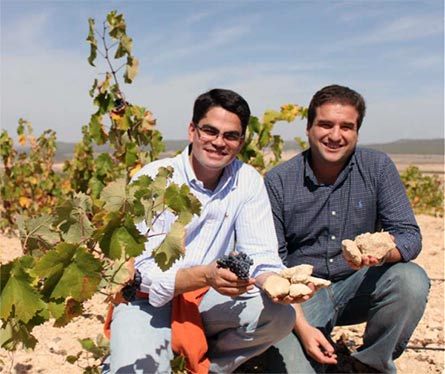
Patrick Mata on the left and Alberto Orte on the right in a vineyard

The logo of Alberto and Patrick´s company
He lodges in his portfolio more than 100 references of different denominations of Spanish origin and sells more than 100,000 boxes of wine from the peninsula per year. Alberto is in charge of the selection of wine and oenology in Spain and Patrick of the commercial and marketing part in the United States; thus both form a perfect business team.
In 2003, Patrick and Alberto decided to found another company, which was directly dedicated to the production of wine, in different areas of Spain, and thus created "Compañía de Vinos del Atlantico", whose fundamental mission is to discover new production areas, unique soils and recover autochthonous varieties. One of their projects is to recover the Tintilla --Tintilla de Rota is a Spanish wine, now almost forgotten, originally from the town of Rota (Cádiz, Costa de la Luz, Southern Spain). It is made from ripe grapes of the variety of the same name, synonymous with the known as Graciano--, through these two great wines: ATLANTIDA and VARA Y PULGAR. The Atlantic Wine Company sells its wines in more than 10 countries, with its main markets: the United States, Germany, Switzerland and Canada.

Wines ATLANTIDA and VARA Y PULGAR
Alberto has a degree in Oenology and Viticulture, from the Polytechnic University, and a Law Degree from the Complutense University, both in Madrid, and has gained a lot of experience in his numerous trips around Spain, working closely with the different wineries, which he represents in U.S.
Some of those wineries are those of the Osborne family, which make up the group of COMPAÑIA DE VIÑEDOS IBERIAN, whose main headquarters are also in El Puerto de Santa Maria. For this relationship of friendship and trust, IBERIAN is responsible for distributing his wines from the land of Cadiz, nationwide.
The second vintage of dry red wine from Cadiz, ATLANTIDA 2012, has already come onto the market and, for the first time, his brother VARA Y PULGAR 2012, both made with 100% tintilla and produced by the Atlantic Wine Company, whose headquarters are in El Puerto de Santa María.

The red wine ATLANTIDA 2012
The first vintage of this wine, ATLANTIDA 2011, had only 66 bottles, for the exclusive US market, mainly New York, where it received excellent reviews, such as Josh Reynolds, from the professional wine magazine International WineCeller (IWC), who gave it a high score, in its first edition. In this vintage, and after the success obtained, 2.500 bottles of ATLANTIDA 2012 and 14.500 bottles of VARA Y PULGAR 2012 have been prepared, and will be destined for the Spanish market 480 and 1800 bottles, respectively.
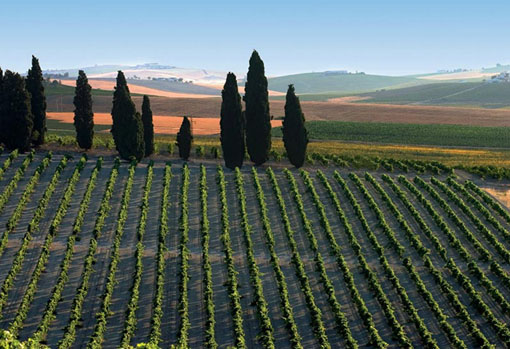
A view of a vineyard of VARA Y PULGAR
Currently, there are 3 hectares of Tintilla grapes from Rota, that the Bodega Luís Pérez has planted in its Vista Hermosa farm in Jerez. A project for which they have been fighting for years. In a first stage, recovering the red wines of the province and, in this second stage, focusing on the native varieties of the area. Guillermo Pérez Vega, oenologist, is very excited and recognises that "In the coming years, Cádiz should look for its identity and do it through the tintilla grape. It is easy because of its character --he thinks--. There is a lot of interest in tintilla, nationally and internationally”. The recovery of the Tintilla, a variety cultivated in the environment of Jerez since the seventeenth and eighteenth centuries, has not been an easy task, because it was practically extinct. Its recovery has gone through a selection, in the field, of the most suitable strains, to get all the quality that this native variety is capable of giving.
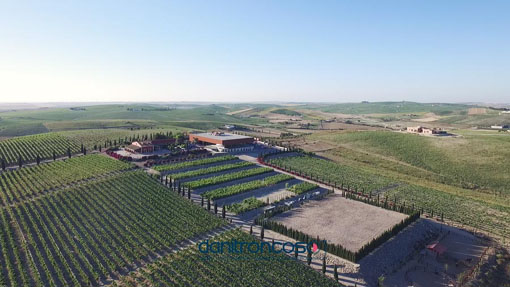
The Luis Perez winery on the Vista Hermosa farm
The philosophy of Winery Luís Pérez "is that the wines speak, not influence the process and let the plant be the one that expresses itself ". The tintilla is a plant that gives a production of 4500- 5000 kilos, per hectare, so the grape-leaf balance is very good. Guillermo Pérez, "Willy", recognises that "the plant is very acclimatised to the area and its acidity is high to be in a warm climate. The Berry is very concentrated, with a lot of colour and tannin”. The specific grape, with which "Tintilla 2012" has been produced, comes from an old vineyard of Tintilla of Rota, called "Calderín del Obispo", located on the Rota-Jerez road.

Guillermo Pérez Vega - Willy- with a bottle of Tintilla 2012
The sale of this new red, which can already be found in specialised shops, coincides with that of other versions launched by other wineries. There are 4 wineries and winemakers that, at the moment, are working with a character of author wine, without mass production and dry vinification of the tintilla. Ramiro Ibáñez and his "Arroyo Alquitón 2012", Miguel Lucas with "Mahara 2011", Alberto Orte "Atlántida 2012" and this one by Luis Pérez. Guillermo highlights that among all these wineries "there is a great twinning and a lot of enthusiasm for the tintilla". To these works we must unite that of Jose Antonio Rodríguez Muñoz, "Peque", sommelier from Rota, who has also produced "Clérigo 2011". Two other wineries are also working on the sweet version of Tintilla, El Gato de Rota and González Byass, which has also released a version of this wine.

Guillermo Pérez and Alberto Orte
Winery Luís Pérez have been fighting for red wines, in the province of Cádiz, for 10 years and, from the beginning, they were interested in the native varieties of the area. In 2002, Graciano grapes were planted, since genetically they were the same as Tintilla. From 2002 to 2006, they continued the tests with the Graciano grape, but did not give the expected result and they set aside the project. At that moment, they began to work with Paco Guerrero, farmer and viticulturist, and in 2011, 500 litres of Tintilla were extracted to make a small vinification and check the results. Both were very happy and decided that one part would be left for Garum Submarino (Winery Luís Pérez) and the other for Atlántida 2011 (prepared by Alberto Orte, with the collaboration of Winery Luis Pérez, for the Atlantic Wine Company).

Tintilla Atlantida 2011 by Alberto Orte
The vintage of the tintilla has been carried out at night and manually. The boxes of grapes collected do not exceed 15 kgs and the selection is made both in the vineyard and in the selection table, in the winery. Vinification is by gravity, 6 months in French oak barrels of 1 year of use and 12 months in barrels of 4-5 years, in this way the varietal character of the wine is respected since the Tintilla is made quickly with aroma of wood. The clusters are totally despalillados –“despalillar” is to separate the grape from its herbaceous structure--. A pre-fermentation maceration is carried out at 5°C and then a controlled temperature fermentation at intervals from 15°C to 28°C with the maceration lasting 20 days. The lees are separated from the fermentation and the most appropriate are selected by tasting. The wine is not clarified.

Oak barrels in the Luis Perez wine cellar
In the tasting, "Tintilla 2012" is characterized by a medium-high garnet colour. In nose, it is intense and frank, with hints of laurel, fresh red fruit, spices and white chocolate. It is characterised by a sweet tannin that makes it silky but powerful, with a roasted and coffee aftertaste. The ideal temperature to serve it is 16º. On the label of the bottle, it is traditional to see the logo of the winery and starring a beautiful dog of the Jack Russell breed and, in "Tintilla", it is next to a strain, "a return to the origin". In its marriage, harmonises with dishes with vegetables, nuts, roasted vegetables; meats, light stews, rice, semi-hard cheeses. As dessert, with quinces or chocolate.
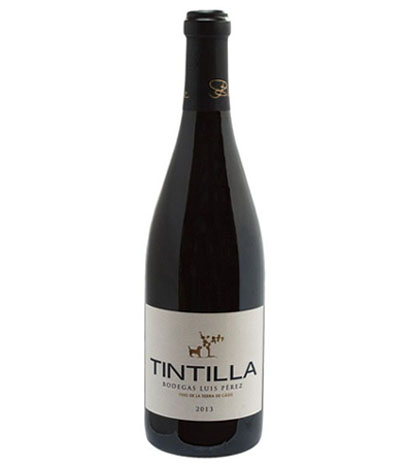
A Jack Russell dog with a strain on a bottle of red wine Tintilla by Luis Perez
On July 28, 2014, the "Tintilla 2012" wine was presented at the "Vista Hermosa" farm, where the Luis Pérez Winery is located.
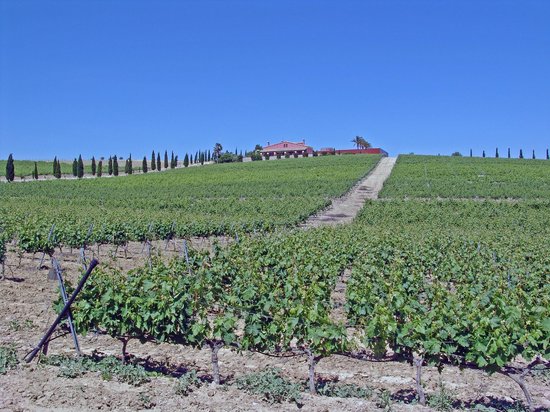
Vista Hermosa farm and Luis Perez Winery on the background
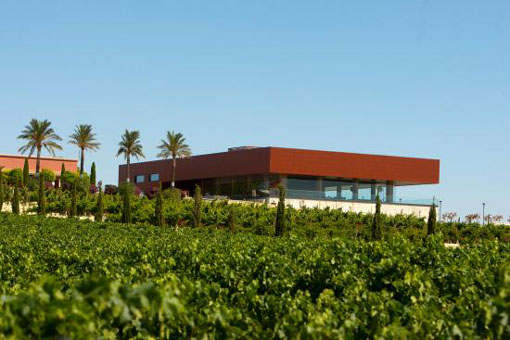
The winery close up
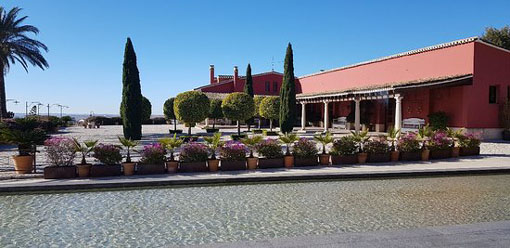
Outside of the wine cellar

The wine Tintilla 2012-Winery Luis Perez
Another variety of Atlántida wine is Atlantida Blanco 2016, prepared by Alberto Orte; this is their first variety of white vijiriega (vine grape little extended, this grape has a vigorous and resistant strain, which produces few bunches of medium size, little tight and thick grapes. This grape, almost round and greenish-white, It was famous as a table grapes formerly. Its juice is rich in sugars and acidity, being especially apt for the production of natural sparkling wine) and the first to be made within the framework of Jerez. This variety, which was very precious and was planted throughout the countryside of Jerez, disappeared from Cádiz with phylloxera (an insect similar to the aphid, but smaller and yellowish, that attacks the leaves and filaments of the roots of the vine; it multiplies rapidly and forms pests that can destroy large areas of vineyards in a short time; It is native to North America. There was a plague at the end of the 19th century) and was present only in some area of Granada, Catalonia and the Canary Islands. Now Vinos del Atlántico has brought it back, has vinified it and has brought to the market an unique wine.
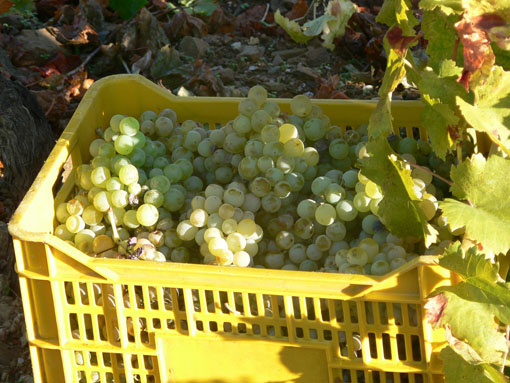
Several bunches of vijiriega grapes
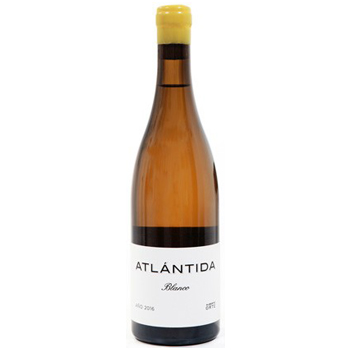
White-wine Atlantida 2016
Atlántida Blanco 2016 has been aged, for 12 months, in demimuds (French oak barrels) of 600 litres and, subsequently, 6 months in a stainless steel tank. It is made by hand, stepped on foot, with indigenous yeasts and without temperature control.
Another type of wine, from the Vinos del Atlantico Company, is "Gordo"; this red wine is born in Yecla (Murcia).

Yecla
Gordo is the story of Alberto Orte and Patrick Mata or, rather, the history of their families, who have been making wines in Spain, since 1820. It is made, by Alberto, in the region of Yecla and the name is dedicated to the Patrick Mata´s father, founding partner with Alberto from the company Vinos del Atlántico.

Red wine Gordo 2012
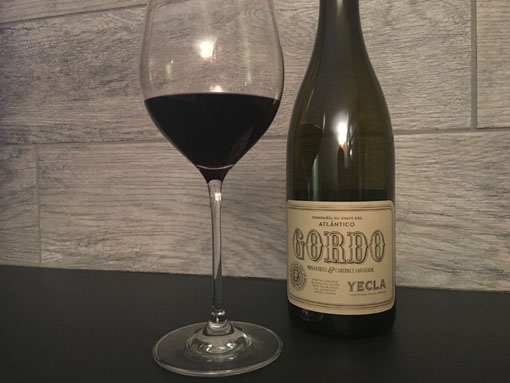
A cup of wine Gordo
What makes this wine unique?. On the one hand, the name, Gordo (Patrick talks to his father in a loving tone), without complexes. On the other, the image, a 'revival' of the labels that the family traded four generations ago.
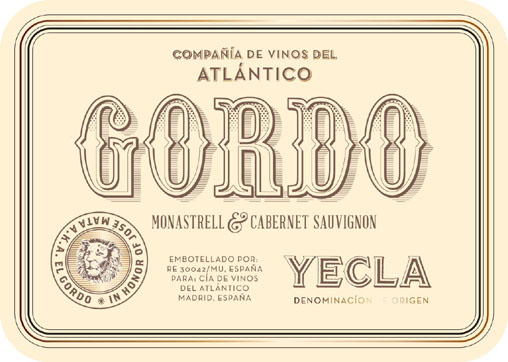
Label of Gordo
But, above all, the vineyards from which it was born: in the Denominacion de Origen (D.O.) (Appellation of origin) Yecla, in the subzone of Campo Arriba at an average altitude of 713 metres above sea level. This altitude produces more balanced, fresh and elegant wines. The soils are very poor, limy and sandy (something magnificent for the quality of the wine). The Monastrell variety is also planted in this case in free standing, a luxury.

Yecla Campo Arriba

Vineyard of Gordo
This red wine has been collecting loas (Expressions with which the qualities of this wine are praised), for years in the United States (Parker's demanding Wine Advocate has given it 91 points) and now it returns to Spain.
These are the characteristics of the red wine "Gordo 2012":
Type of grape: 70% Monastrell, 30% Cabernet Sauvignon.
Bottle: Burgundy of 75 cl.
Elaboration and aging: 3 months in French oak barrels.
Degree: 14%
These are some tasting´s notes:
View: Cherry red color
Nose: The smoked and spicy notes stand out.
Mouth: Very expressive and tasty. Broad and meaty
Service temperature: 16ºC.
Well, I hope that you will like this article.
Until my next post, kind regards,
Luis.
Please click below:
